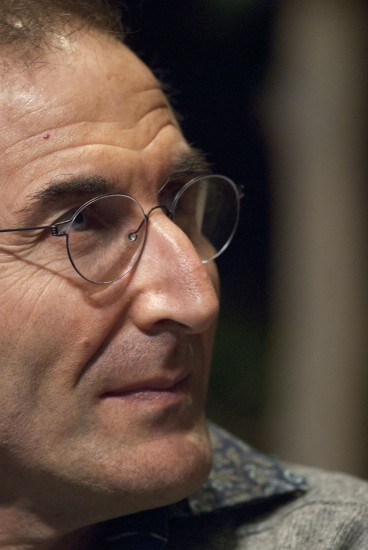On Thursday, September 29, 2011, Connecticut College was treated to a phenomenal guest lecture thanks to The Sherman Fairchild Foundation. Upon an invitation from the dynamic David duo, professors David Dorfman (Dance Department) and David Kim (Religious Studies), Professor Randy Martin, Chair of the Art and Public Policy department at New York University, presented a lecture to an audience of students, faculty and staff entitled, “Dance & The Social Logic of the Derivative.”
With bright eyes and an eager stance, Martin gave a warm welcome to his audience and dove right into his presentation of the topic of his lecture. As founder and chair of a department that is interdisciplinary in nature, Martin’s topic of choice naturally had a multifaceted focus; in his presentation, he aimed to explain the relationship between dance and finance in our society. He made note that in its essence, finance has a “compulsory movement”; however, he added, “in this compulsion to move, there isn’t much insight.” Finance does not have a component that aids us in understanding its true essence. It was through his lecture that Martin aimed to demonstrate how we can use art, namely dance, to give finance a voice of explanation and therefore bring forth a sense of understanding to those who otherwise would be lost in the confusing world of finance.
Before officially beginning his lecture, Martin sought the aid of his audience to provide some framework for the rest of the talk. He posed the following classifying question: “What is your sense or understanding as to what [our] financial disaster or debacle is?” The room seemed to come to a general consensus that our financial position has fallen into disarray for various reasons. Martin agreed with this sentiment; however, he desired to use his lecture to not solely agree that our financial state has fallen into ruins and thus “settle for [these] ruins”, but to employ methods with which we can figure out what can come of what is left of the system and identify “the phoenix that can rise from these ashes.”
Martin started his lecture by explaining the fundamental elements of finance. He explained to us that the root of the word finance, ‘fin’, comes from the French for ‘end.’ Thus, finance is “the means by which we bring a transaction to an end.” Martin explained that with this concept in mind, we have structured our financial interactions so that we can investigate “today” the future outcomes of our transactions. He also believes that within this concept, “some part of the relationship of the future and the present has gone awry.” It is at this place that we find ourselves in financial crises like the one our country is currently facing.
Finance chops up our homes, our cars and even our very own identities into specific attributes, characteristics and qualities in an effort to “try to anticipate a profitable risk that can be acted on ‘today’, ” Martin argued forcefully. This break down of our various “possessions” is referred to as the derivative. For instance, if you break a person’s identity up into the various derivatives you may come up with a list like the following: black, American, daughter, friend, artist, student and leader. You thus take that person’s singular identity and, in a sense, multiply it. We as a society do this all the time, and thus identity, as Martin put it, “ has become more and more fluid over time,” and because of this “we have naturalized the language of the derivative.” Through this idea of measuring identify in order to measure risk Martin believes we have “created unmanageable risks.”
Martin continued to explain many more financial concepts and historical occurrences, specifically those relevant to the United States. After explaining the lack of clarity that finance brings about, and in effect covering the room with a thick layer of confusion, Martin did however note very clearly that the occurrence of making things (identifying certain characteristics or qualities) and giving them value (deciding how much each of those attributes is worth) was happening at the same time and he likened this occurrence to the composition of a dance, and consequently, he began to link the financial principles he’d explained to the history of movement.
He introduced a concept called the social kinesthetic that is a value of a society translated into movement. When financial sovereignty was not evident, it could be reinforced by the social kinesthetic. For instance, in the creation of ballet, the social kinesthetic is height, length or more directly an “assent to the heavens” and a connection to God. This was a translation of King Louis XIV’s declaration of sovereignty. Because he was connected to God as the king, his performance of the ballet movements, as well as the overall aesthetic of the technique, ought to reflect this fact as well. This was just the beginning of the connections made between finance and dance.
We then proceeded to watch three videos: Trisha Brown’s “A Man Walking Down the Side of the Building,” the theatrical trailer of “Dogtown and the Z-Boys,” and a clip from Style Wars called “Throwdown at USA.” After watching these videos and briefly discussing them, we identified that out of the ruination of three different areas of housing, the artists in the videos were able to be innovative and create off the very surfaces of ruin. It was here that Martin brought home his main point. In this examination of the dance, we were able to answer questions about the process of moving through poor financial circumstances that lead ruin to some form of creative achievement. Professor Martin urged us to understand that by looking to dance we can find “sources of value that can lead us to greater collective appreciation” of the things that surround us. It is from this point of view that we can see dust yet also imagine the phoenix that rises from it. •









